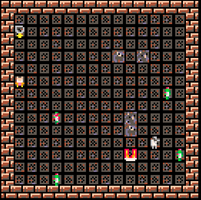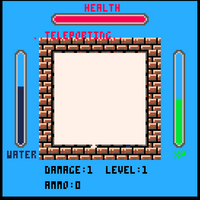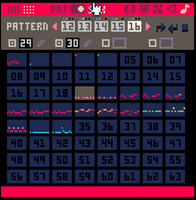How I Created Lost in Place for MiniJam98 "Empty" Limitation Roguelike







Devlog for Lost in Place 01/24/22
Here is my devlog on how I created Lost in Place a Roguelike for MiniJam98 with the theme of "Empty" in under 72 hours.
First of all I needed to know what exactly is a Roguelike so I started where any normal person would start, Wikipedia. Basically I learned that I the required elements of a Roguelike are procedurally generated maps, permadeath and lots of random items and effects. I chose to use PICO-8 because I already had an idea of how procedural generation would work, although I admit I was looking forward to testing my ability in Unity. So with the game engine chosen and the type of game determined I was onto the story boarding or the concept art phase of my game design.
Concept art is the simplest, yet most effective stage of game design. It offers a platform for your creativity to launch without restrictions. I have only recently begun making concept art and I find it helpful when you are "creatively bankrupt" later down the line (which happens frequently after staring at code for 10+ hours straight). Your concept art shouldn't be perfect in any way or even represent what your game will actually look like, it is just a simple mechanism that illustrates what elements are needed and how they might be implemented. In my case I was originally going to make a car that runs out of fuel hence the game jam's theme "empty". However, I determined the graphics would be too intense so I decided on a more of a generic dungeon crawler art style.
Onto the actual game creation phase! At this point I know what game I want to make and I have an idea of how it will look. From here there are many different ways to start out, but I decided to draw out my sprites first. This turned out to be a good choice and I will probably start doing graphics in the early stages of my future projects going forward because it avoids the whole "creatively bankrupt" problem I find myself in frequently as the deadline approaches. It also helps when you are coding to already have your graphic assets ready to test because you aren't stopping and switching gears to create something then going back to coding (I find this very difficult!). So with my basic sprites created (most of which were changed later on or not used) I could move onto coding the game.
I won't get too into how I actually coded the game, but by the time I was done In PICO-8 I had used 5700/8000 tokens although the basic version of the game was closer to 2000/8000. I spent most of my time in the beginning coding the map, making sure to use random sprites for the floor and creating "blocks" that the player and enemies couldn't move through. Then I moved onto enemy movement and player movement. This took me the better part of a day and another day to get the action animations and combat mechanics working properly. This left me one day to finish the rest which was, multi-level design, vary enemies and sound. Oh I also hadn't coded the items or water mechanic at this point yet either although those took surprisingly little time.
So basically once I had the player, enemy and map all coded and working properly I could move onto the HUD elements. This was the health bar, water bar and XP bar. I actually struggled with these elements as I wanted to create a reactive health bar using sprites such that the player could increase their max health or max water, but fractions are very difficult (impossible?) in PICO-8 and at this point I had spent 30+ hours coding so I couldn't think of a solution. I left it as an 8/8 with each point down generating a different sprite on the health bar since there were 8 bars that filled up. Not practical, but it was a solid solution that I used on the health and XP bars too.
Once I had the HUD working as well as all the interactions that change the HUD I went to the final phase which for me was level design. After beating 3 levels of the current map the map changes. I didn't have much time left so the playability doesn't change as much as I would have liked it to with the further levels, but I came to a compromise that I was happy with.
Finally I created the soundtrack as well as all the sound effects in PICO-8. PICO-8 has a great system for creating music and sound effects and this greatly sped up the process for me which is why I left it for last. After some hours of testing and adjusting I was ready to submit my game. I am happy with what I accomplished, however there are still many elements that I can improve on (graphics for one!). I look forward to my next game jam and invite all the constructive feedback you have!
TLDR: Careful planning pays off!
Thanks for reading I hope you learned something xD
Lost in Place
Roguelike game made for Mini-Jam98 with the theme "Empty". Survive all three levels of this mini-RPG Dungeon Crawler!
| Status | Released |
| Author | Poop Dollar |
| Genre | Survival, Adventure, Role Playing |
| Tags | Arcade, Dungeon Crawler, PICO-8, Roguelike, Roguelite, Singleplayer, Top down shooter |

Leave a comment
Log in with itch.io to leave a comment.